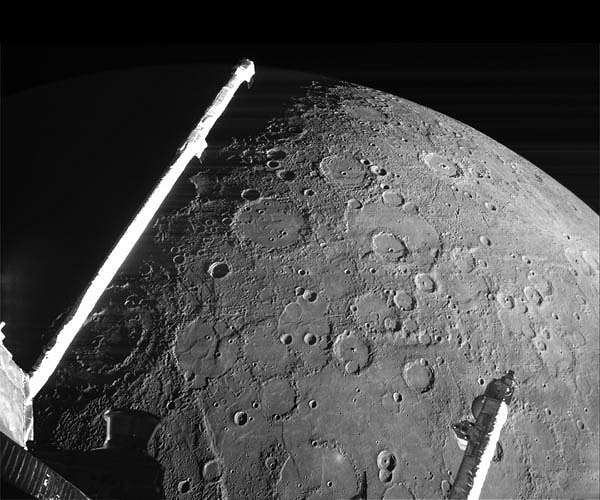
Second helpings of Mercury (Image Credit: Space Daily)
The ESA/JAXA BepiColombo mission has made its second gravity assist of planet Mercury, capturing new close-up images as it steers closer towards Mercury orbit in 2025. The closest approach took place at 09:44 UTC (11:44 CEST) on 23 June 2022, about 200 km above the planet’s surface. Images from the spacecraft’s three monitoring cameras (MCAM), along with scientific data from a number of instruments, were collected during the encounter.
The MCAM images, which provide black-and-white snapshots in 1024 x 1024 pixel resolution, were downloaded over the course of yesterday afternoon, and a selection is presented here (click images to expand captions for more details).
“We have completed our second of six Mercury flybys and will be back this time next year for our third before arriving in Mercury orbit in 2025,” says Emanuela Bordoni, ESA’s BepiColombo Deputy Spacecraft Operations Manager.
Because BepiColombo’s closest approach was on the planet’s nightside, the first images in which Mercury is illuminated were taken at around five minutes after close approach, at a distance of about 800 km. Images were taken for about 40 minutes after the close approach as the spacecraft moved away from the planet again.
As BepiColombo flew from the nightside to dayside, the Sun seemingly rose over the cratered surface of the planet, casting shadows along the terminator – the boundary between night and day – and highlighting the topography of the terrain in dramatic fashion.
Jack Wright, a member of the MCAM team, and a research fellow based at ESA’s European Space Astronomy Centre (ESAC) in Madrid, helped to plan the imaging sequence for the flyby. He said: “I punched the air when the first images came down, and I only got more and more excited after that. The images show beautiful details of Mercury, including one of my favourite craters, Heaney, for which I suggested the name a few years ago.”
Heaney is a 125 km wide crater covered in smooth volcanic plains. It hosts a rare example of a candidate volcano on Mercury, which will be an important target for BepiColombo’s high resolution imaging suite once in orbit.
Just a few minutes after closest approach and with the Sun shining from above, Mercury’s largest impact feature, the 1550 km-wide Caloris basin swung into view for the first time, its highly-reflective lavas on its floor making it stand out against the darker background.
The volcanic lavas in and around Caloris are thought to post-date the formation of the basin itself by a hundred million years or so, and measuring and understanding the compositional differences between these is an important goal for BepiColombo.
“Mercury flyby 1 images were good, but flyby 2 images are even better,” commented David Rothery of the Open University who leads ESA’s Mercury Surface and Composition Working Group and who is also a member of the MCAM team. “The images highlight many of the science goals that we can address when BepiColombo gets into orbit. I want to understand the volcanic and tectonic history of this amazing planet.”
BepiColombo will build on the data collected by NASA’s Messenger mission that orbited Mercury 2011-2015. BepiColombo’s two science orbiters – ESA’s Mercury Planetary Orbiter and JAXA’s Mercury Magnetospheric Orbiter – will operate from complementary orbits to study all aspects of mysterious Mercury from its core to surface processes, magnetic field and exosphere, to better understand the origin and evolution of a planet close to its parent star.
Even though BepiColombo is currently in ‘stacked’ cruise configuration, meaning many instruments cannot be fully operated during the brief flybys, they can still grab insights into the magnetic, plasma and particle environment around the spacecraft, from locations not normally accessible during an orbital mission.
“Our instrument teams on both spacecraft have started receiving their science data and we’re looking forward to sharing our first insights from this flyby,” says Johannes Benkhoff, ESA’s BepiColombo project scientist. “It will be interesting to compare the data with what we collected on our first flyby, and add to this unique dataset as we build towards our main mission.”
BepiColombo’s main science mission will begin in early 2026. It is making use of nine planetary flybys in total: one at Earth, two at Venus, and six at Mercury, together with the spacecraft’s solar electric propulsion system, to help steer into Mercury orbit. Its next Mercury flyby will take place on 20 June 2023.
Related Links
BepiColombo at ESA
News Flash at Mercury
Mars News and Information at MarsDaily.com
Lunar Dreams and more
|
|
Tweet |
|
|
|
We need your help. The SpaceDaily news network continues to grow but revenues have never been harder to maintain. With the rise of Ad Blockers, and Facebook – our traditional revenue sources via quality network advertising continues to decline. And unlike so many other news sites, we don’t have a paywall – with those annoying usernames and passwords. Our news coverage takes time and effort to publish 365 days a year. If you find our news sites informative and useful then please consider becoming a regular supporter or for now make a one off contribution. |
||
|
SpaceDaily Monthly Supporter $5+ Billed Monthly |
SpaceDaily Contributor $5 Billed Once credit card or paypal |
|
BepiColombo lines up for second Mercury flyby
Paris (ESA) Jun 21, 2022
The ESA/JAXA BepiColombo mission is gearing up for its second close flyby of Mercury on 23 June. ESA’s spacecraft operation team is guiding BepiColombo through six gravity assists of the planet before entering orbit around it in 2025.
Like its first encounter last year, this week’s flyby will also bring the spacecraft to within about 200 km altitude above the planet’s surface. Closest approach is anticipated at 09:44 UT (11:44 CEST).
The primary purpose of the flyby is to use the planet’s gr … read more









